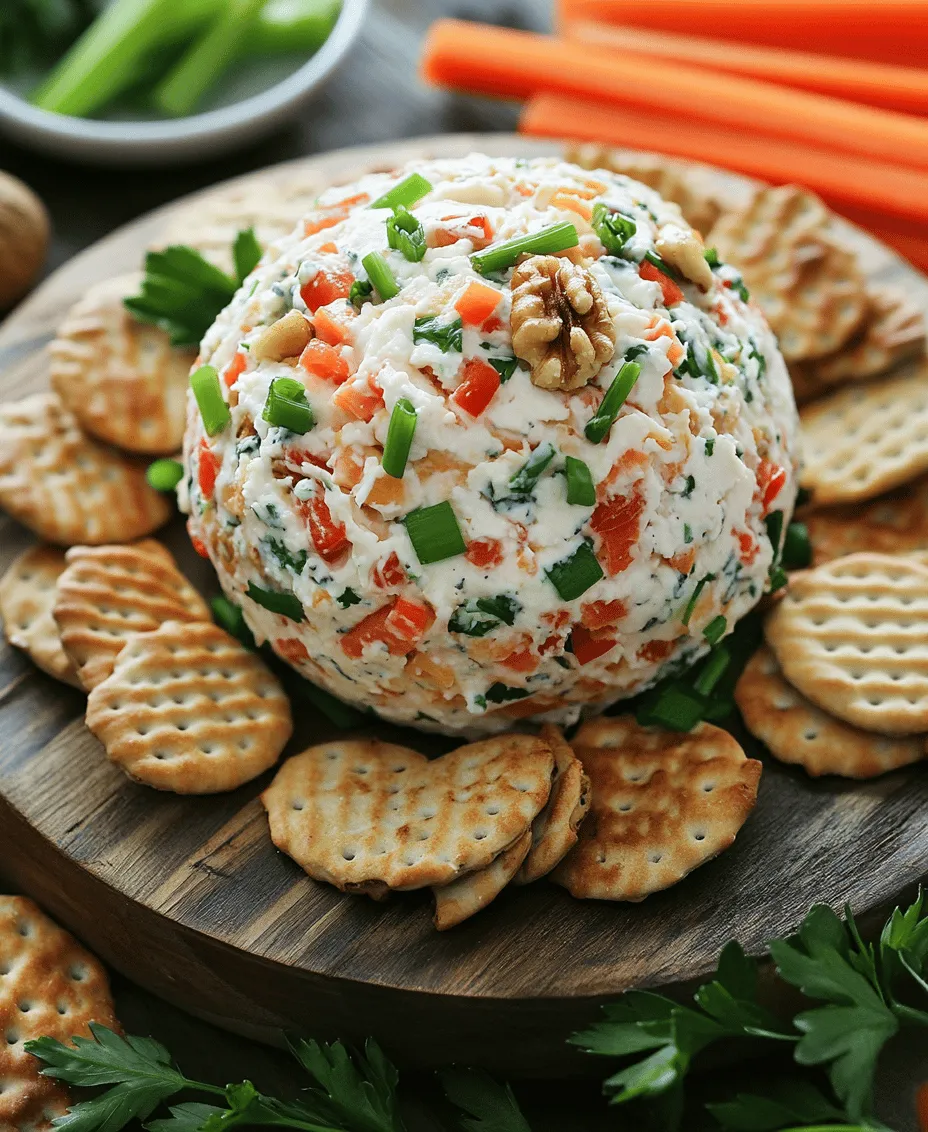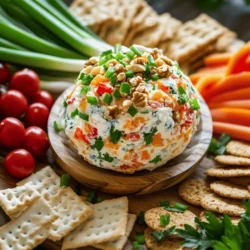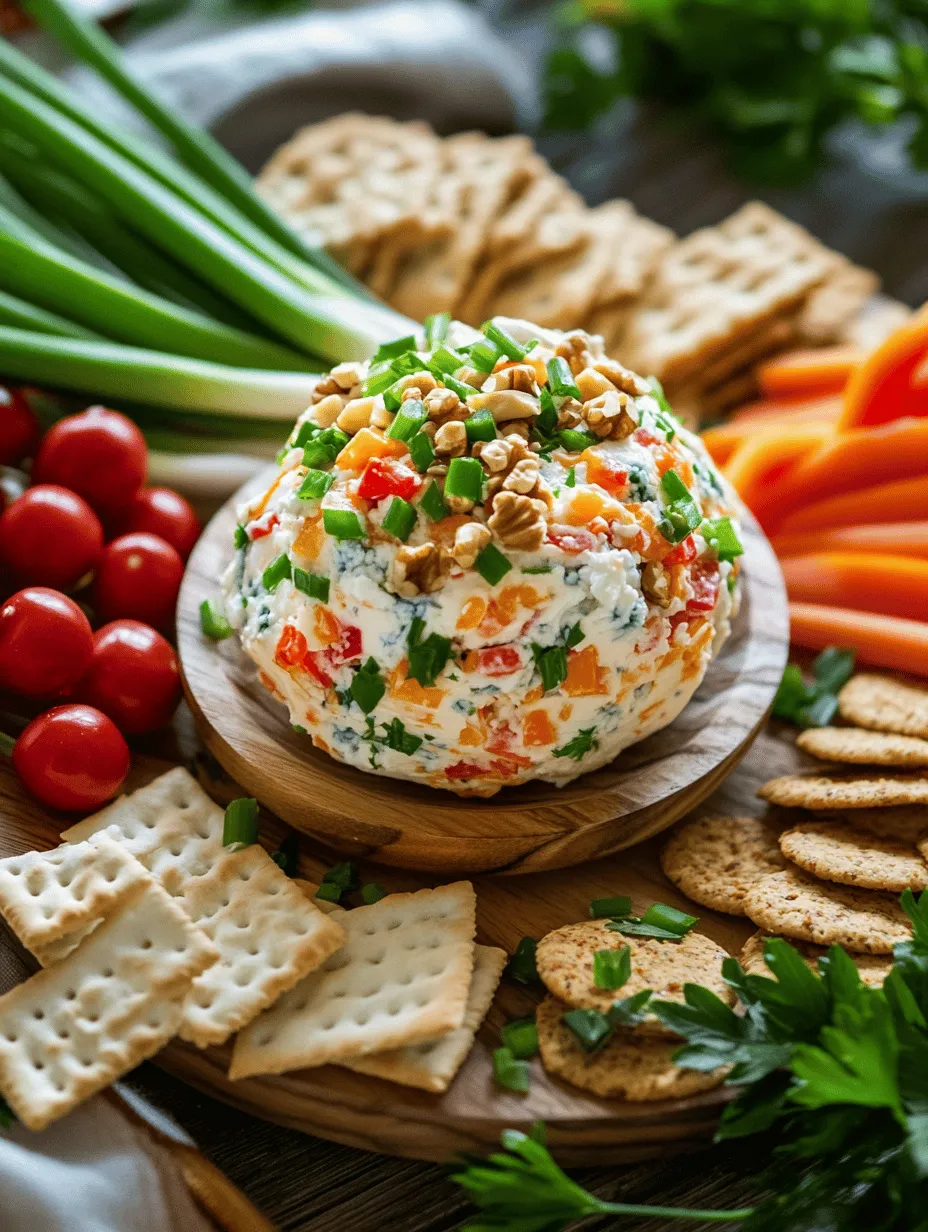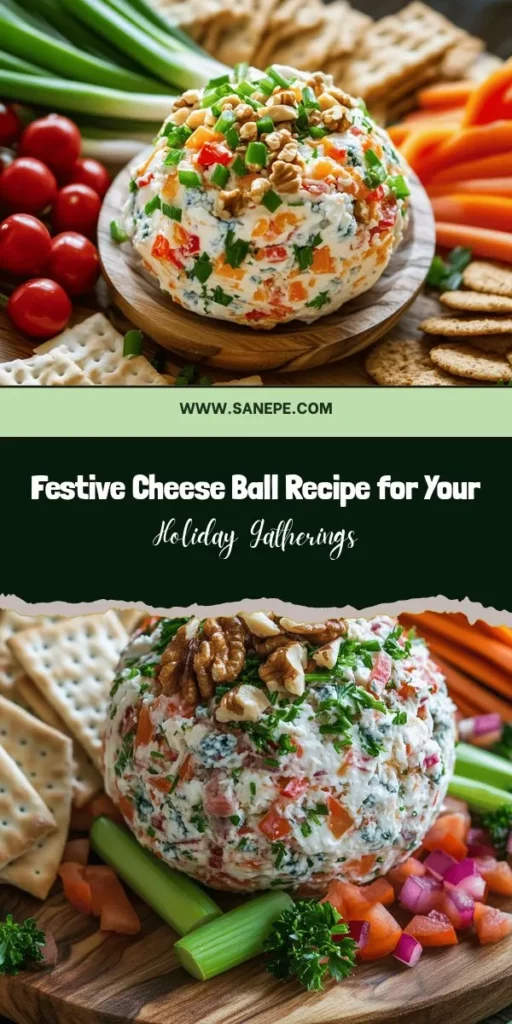Introduction
Crafting a memorable holiday gathering often revolves around delicious food, and nothing brings people together quite like a beautifully presented cheese ball. This Festive Holiday Cheese Ball Recipe combines creamy textures and bold flavors, making it the perfect centerpiece for your celebrations. Whether you’re hosting an intimate family gathering or a larger holiday party, this cheese ball is sure to impress your guests and elevate your festive spread.
As we delve into this delightful recipe, we’ll explore the ingredients that contribute to its unique taste, the preparation steps required to create this creamy delight, and some fun tips to make your cheese ball even more festive. Cheese balls have been a staple at gatherings for decades, and with their rich history and versatility, they continue to be a favorite among hosts and guests alike.
Understanding the Cheese Ball: A Holiday Tradition
The Origin of Cheese Balls
The cheese ball has a storied history that dates back several centuries. Initially, cheese was crafted by early civilizations as a means of preserving milk, and over time, various cultures began to experiment with different flavors and presentations. The concept of rolling cheese into a ball format likely emerged as a practical solution for serving and sharing, allowing hosts to easily present cheese at gatherings.
By the 19th century, the cheese ball began to gain popularity as a party dish in America. Its delectable combination of cream cheese and assorted flavorings made it a beloved appetizer during holiday festivities and family gatherings. The cheese ball’s appeal lies not only in its taste but also in its visual presentation. When rolled in colorful herbs, nuts, or spices, it creates an inviting centerpiece on any table, beckoning guests to indulge.
The Appeal of Cheese Balls
One of the primary reasons cheese balls have remained popular throughout the years is their versatility in flavor combinations. From savory to sweet, cheese balls can be customized to suit any palate or occasion. This adaptability allows hosts to cater to diverse taste preferences, ensuring that everyone at the gathering finds something they enjoy.
Moreover, cheese balls are remarkably easy to prepare and serve. With minimal cooking involved, you can whip up this delightful appetizer in no time. Simply combine the ingredients, form the mixture into a ball, and chill it until ready to serve. Pair it with an assortment of crackers, fruits, and vegetables, and you have an impressive starter that requires little to no effort.
Ingredient Breakdown: What Makes This Cheese Ball Shine
Creating a standout cheese ball requires a careful selection of ingredients. Each component contributes to the overall flavor, texture, and visual appeal, making the cheese ball a memorable addition to any holiday table. Let’s take a closer look at the ingredients that make this Festive Holiday Cheese Ball a must-try.
Cream Cheese: The Creamy Base
The foundation of any cheese ball is cream cheese, providing a rich and creamy base that binds the other ingredients together. It’s essential to use softened cream cheese, as this allows for easier mixing and ensures a smooth texture. Room temperature cream cheese will blend seamlessly with the other components, creating a luscious mouthfeel that melts in your mouth.
When it comes to choosing cream cheese, there are several variations available. Regular cream cheese offers a classic taste that pairs well with most flavor profiles, while low-fat or non-fat options can be used for a lighter version. However, keep in mind that these alternatives may not yield the same creamy consistency, so it’s best to stick with full-fat cream cheese for the richest results.
Cheddar Cheese: A Sharp Contrast
Adding a sharp cheddar cheese to the mix introduces a delightful contrast to the creaminess of the cream cheese. The tangy flavor of sharp cheddar enhances the overall taste of the cheese ball, making each bite more complex and satisfying. Opt for freshly grated cheddar for the best results, as pre-packaged varieties often contain anti-caking agents that can affect the texture.
If you prefer a milder flavor, feel free to experiment with medium or mild cheddar. Alternatively, you can mix in other cheese varieties—such as pepper jack for a spicy kick or gouda for a smoky flavor—allowing you to create a cheese ball that perfectly suits your taste preferences.
Blue Cheese vs. Feta: Choosing Your Favorite
The choice between blue cheese and feta adds another layer of flavor to your cheese ball. Blue cheese has a distinctive pungency, with its tangy and salty notes creating a bold contrast to the creamy elements. On the other hand, feta cheese provides a crumbly texture and a milder flavor, making it an excellent option for those who prefer a less intense taste.
When selecting between blue cheese and feta, consider your guests’ preferences and dietary restrictions. If you’re unsure, you can use a combination of both cheeses to appeal to a broader audience. Remember, the key to a fantastic cheese ball lies in balancing flavors and textures, so choose the cheese that resonates most with your palate.
Fresh Vegetables: Adding Color and Crunch
To elevate the visual appeal and provide a refreshing crunch, incorporating fresh vegetables is essential. Green onions and red bell peppers are popular choices that add vibrant color and a burst of flavor to your cheese ball.
Green onions offer a mild onion flavor that complements the richness of the cheese, while red bell peppers add a sweet crunch that brightens the dish. In addition to their flavor contributions, these vegetables also pack nutritional benefits, providing vitamins and antioxidants that enhance the overall healthfulness of the appetizer. Feel free to get creative with your vegetable choices—diced cucumbers, jalapeños, or even finely chopped herbs can add their unique flair to the cheese ball.
Nuts: The Crunch Factor
Nuts play a crucial role in adding texture and flavor to your cheese ball. Whether you choose walnuts or pecans, these ingredients contribute a delightful crunch that contrasts beautifully with the creamy base. Walnuts have a slightly bitter flavor that pairs well with the richness of the cheese, while pecans offer a sweeter, buttery taste.
In addition to enhancing the flavor and texture, nuts also provide health benefits. They are a good source of healthy fats, protein, and fiber, making your cheese ball a more nutritious option. Toasting the nuts before incorporating them into the cheese ball can amplify their flavor and add an extra layer of depth to the dish.
Flavor Enhancers: Worcestershire Sauce and Dijon Mustard
To elevate the overall taste of your cheese ball, don’t overlook the importance of flavor enhancers like Worcestershire sauce and Dijon mustard. These ingredients add depth and complexity, transforming an ordinary cheese ball into a gourmet delight.
Worcestershire sauce brings a savory, umami flavor that enhances the richness of the cheese, while Dijon mustard introduces a tangy kick that balances the creaminess. If you have dietary restrictions, there are suitable substitutes available; for example, soy sauce can replace Worcestershire sauce, and yellow mustard can stand in for Dijon in a pinch.
Seasoning: The Final Touch
Finally, the seasoning is what ties everything together. Garlic powder and onion powder are essential components that add an aromatic depth to your cheese ball. These seasonings enhance the overall flavor without overpowering the other ingredients, creating a harmonious blend that will have your guests coming back for more.
When seasoning your cheese ball, it’s essential to taste as you go. Start with a small amount of each seasoning and adjust according to your preferences. Remember, the goal is to enhance the flavors while allowing the individual ingredients to shine.
As we move forward in this article, we will explore the step-by-step instructions on how to make this Festive Holiday Cheese Ball, ensuring that you can create a delicious centerpiece for your holiday gatherings that will leave everyone raving. Stay tuned for the next section, where we’ll dive into the preparation process and share tips for making your cheese ball truly unforgettable.

Balancing Flavors with Salt and Pepper
When crafting the perfect cheese ball, achieving the right balance of flavors is essential. Salt and pepper are the unsung heroes of seasoning, enhancing the overall taste of your cheese ball without overpowering it. While mixing together your ingredients, start with a small pinch of salt and a few cracks of black pepper. Taste as you go, adjusting the seasoning according to your preference. Remember, the goal is to enhance the natural flavors of the cheese and the other ingredients, so take your time to find that perfect balance.
Step-by-Step Instructions: Creating the Perfect Cheese Ball
Mixing the Ingredients
The first step in creating your Festive Holiday Cheese Ball is to combine all the ingredients thoroughly. In a large mixing bowl, add your cream cheese, shredded cheese, herbs, spices, and any additional flavorings you desire, such as garlic powder or onion powder.
Tips for Achieving a Creamy Texture
To ensure a smooth and creamy texture, it’s crucial to use room-temperature cream cheese. Cold cream cheese can lead to lumps in your cheese ball. If you forgot to take it out of the fridge ahead of time, you can microwave it for about 10 seconds to soften it slightly.
Using a hand mixer or a stand mixer can also help achieve that creamy consistency. Mix on medium speed until the ingredients are fully blended, but be careful not to over-mix, as this can change the texture.
Ensuring Even Distribution of Flavors
Once your mixture is creamy, take a moment to ensure that all the flavors are evenly distributed. Use a spatula to scrape down the sides of the bowl, and mix the ingredients gently by hand for the final touches. This will help prevent any surprise bites of overwhelming seasoning or unblended ingredients in your cheese ball.
Shaping the Cheese Ball
With your mixture ready, it’s time to shape it into a ball.
Techniques for Forming a Perfect Sphere
To form a perfect sphere, first, use a large spoon or an ice cream scoop to portion out the mixture. Wet your hands lightly to prevent sticking, then roll the mixture between your palms until it forms a smooth ball.
If you prefer a more rustic look, you can opt for several smaller cheese balls instead of one large one. This not only allows for a variety of flavors if you choose to make multiple types but also makes for easier serving at gatherings.
Chilling: Why It’s Essential
Chilling your cheese ball is a crucial step that should not be overlooked.
The Science Behind Chilling for Flavor Development
When you chill your cheese ball, the flavors have time to meld together, allowing the individual ingredients to harmonize. The chilling process also firms up the cheese ball, making it easier to slice and serve.
Recommended Chilling Times for Optimal Taste
For the best results, wrap your cheese ball in plastic wrap and refrigerate it for at least 2 to 4 hours. If you have the time, letting it chill overnight will enhance the flavor even further.
Garnishing for Festivity
Once your cheese ball has chilled, it’s time to add the finishing touches that will make it visually appealing.
Ideas for Rolling the Cheese Ball in Herbs or Nuts
Rolling your cheese ball in finely chopped herbs, such as parsley or chives, or nuts, like pecans or walnuts, can create a beautiful and festive exterior. The crunchy texture of nuts or the fresh taste of herbs adds another layer of flavor and visual appeal.
Presentation Tips for an Eye-Catching Display
Consider using a decorative serving platter to present your cheese ball. You can garnish the platter with additional herbs, edible flowers, or even slices of seasonal fruit to create an inviting display. A well-arranged platter not only enhances the appearance but also encourages guests to dig in.
Serving Suggestions: Pairing with Crackers and Vegetables
Choosing the Right Accompaniments
A cheese ball is not just a standalone treat; it’s best enjoyed with a variety of accompaniments that complement its creamy texture and flavorful profile.
Best Types of Crackers for Cheese Balls
For a cheese ball, you’ll want to choose crackers that can hold up to the richness of the cheese. Opt for water crackers, whole grain crackers, or artisan crackers with seeds. These options provide a neutral base that won’t compete with the flavors of the cheese ball but will enhance the overall experience.
Complementing Flavors with Vegetable Sticks
Fresh vegetable sticks, such as carrots, celery, and bell peppers, are perfect for dipping into your cheese ball. They add a refreshing crunch that balances the creaminess of the cheese. Additionally, the vibrant colors of the vegetables can elevate the visual appeal of your serving platter.
Creating a Festive Serving Platter
Arranging the Cheese Ball and Accompaniments
When arranging your cheese ball and its accompaniments, think about balance and color. Place the cheese ball in the center of a large platter and surround it with an array of crackers and vegetable sticks. Mixing textures and colors will make your platter more inviting.
Ideas for Adding Seasonal Decor to Your Platter
For a seasonal touch, consider adding small decorations like sprigs of rosemary or cranberries around the edges of your platter. Not only do these decorations add to the festive atmosphere, but they also provide additional flavors that guests can enjoy.
Nutritional Information: Enjoying Responsibly
Caloric Breakdown
Understanding the nutritional information of your cheese ball can help you enjoy it responsibly. The primary ingredients, like cream cheese and shredded cheese, provide a rich source of protein and calcium. However, portion sizes are important, especially during festive gatherings where many dishes are available. A typical serving size is about 2 tablespoons, which can range from 100 to 150 calories, depending on the specific ingredients used.
Nutritional Benefits of Key Ingredients
Cream cheese, particularly when made with lower-fat options, offers a creamy texture without too many calories. Additionally, cheese is a good source of calcium, which is essential for bone health. The addition of herbs and vegetables not only enhances flavor but also contributes vitamins and antioxidants, making your cheese ball a more nutritious option.
Dietary Modifications
Options for Gluten-Free or Vegan Guests
If you’re hosting guests with dietary restrictions, consider making a gluten-free cheese ball. You can use gluten-free crackers or vegetables as dippers. For vegan guests, you can create a plant-based cheese ball using cashews or a store-bought vegan cream cheese alternative.
Substitutions That Maintain Flavor and Texture
If you’re looking to modify the recipe while maintaining its delicious flavor, consider using Greek yogurt instead of sour cream for a tangy twist. Nutritional yeast can be an excellent substitute for cheese, providing a cheesy flavor without the dairy.
Conclusion
The Festive Holiday Cheese Ball is more than just an appetizer; it’s a delightful blend of flavors and textures that enhances any holiday gathering. This recipe not only showcases the ease of preparation but also the joy of sharing delicious food with loved ones. As you prepare for your next celebration, consider the impact this creamy delight can have on your table, igniting conversations and creating cherished memories. Enjoy the festivities and the delectable flavors that this cheese ball brings!


